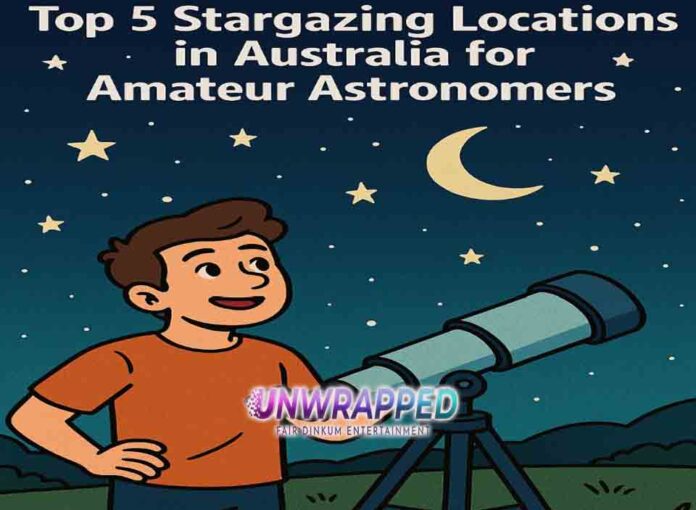Australia’s sprawling landscapes and minimal light pollution make it a stargazer’s paradise, especially for amateur astronomers eager to explore the night sky. From the rugged outback to pristine national parks, the country offers unparalleled views of constellations, planets, and even the dazzling Aurora Australis. For those with a telescope or just a curious eye, these locations promise a front-row seat to the universe’s greatest show, no advanced degree required!
This article spotlights the top 5 stargazing locations in Australia perfect for beginners and seasoned hobbyists alike. Each spot blends natural beauty with stellar visibility, offering unique experiences like guided tours, Indigenous storytelling, and access to cutting-edge observatories. Get ready to discover where the Milky Way shines brightest and why Australia is a must-visit for anyone who loves gazing upward.
The Best Stargazing Spots Down Under
1. Warrumbungle National Park, New South Wales
Nestled six hours northwest of Sydney, Warrumbungle National Park holds a rare title: Australia’s first Dark Sky Park, as recognized by the International Dark-Sky Association. This status ensures minimal light pollution, letting amateur astronomers marvel at a sky bursting with stars. The park’s volcanic landscape adds a dramati backdrop to the celestial display.
The Siding Spring Observatory, perched nearby, houses Australia’s largest optical telescope, though it’s reserved for professionals after dark. For hobbyists, the old-fashioned way—using binoculars or the naked eye—works wonders here. Camp at sites like Camp Blackman, where clear nights reveal the Southern Cross and Orion in stunning detail. Fun fact: the park’s high altitude and dry climate amplify visibility, making it a dream for astrophotography buffs.
People Also Love: Cycling Adventures in the Northern Territory: Routes for Beginners
2. Uluru, Northern Territory
Uluru, the iconic red rock in Australia’s heart, isn’t just a daytime marvel—it’s a stargazing hotspot too. The vast desert surroundings mean almost zero light pollution, letting the Milky Way stretch across the sky like a cosmic blanket. Studies from National Geographic highlight Uluru’s arid, remote setting as ideal for spotting galaxies and nebulae.
Visitors can join the Outback Sky Journey at Ayers Rock Resort, where guides blend astronomy with Indigenous Anangu stories about the stars. Imagine peering through a telescope at Saturn’s rings while learning how the Pleiades inspired local lore. Bring a blanket and a sense of wonder—this is self-care and science rolled into one unforgettable night.
3. Arkaroola Wilderness Sanctuary, South Australia
Tucked in the Flinders Ranges, Arkaroola Wilderness Sanctuary earned its stripes as Australia’s first Dark Sky Sanctuary, a designation from the DarkSky International. Its remote, high-altitude location—429 kilometers from Adelaide—offers pristine skies free of urban glow. Amateur astronomers flock here for a choose-your-own-adventure stargazing experience.
The sanctuary’s Arkaroola Astronomical Observatory provides telescope sessions, while the Ridgetop Sleepout lets campers soak in the stars from prime vantage points. Look out for the Eta Carinae Nebula, a glowing cloud of gas visible in the Southern Hemisphere. With guided tours weaving in Adnyamathanha cultural insights, it’s a spot where science meets soul.
4. Perth Observatory, Western Australia
Just 40 minutes east of Perth in the Bickley Valley, Perth Observatory blends accessibility with stellar views. As Western Australia’s oldest astronomical site, managed by the Perth Observatory Volunteer Group, it’s a haven for amateurs seeking expert guidance. The surrounding hills cut down light pollution, making it a surprising urban-adjacent gem.
Night Sky Tours here showcase planets, star clusters, and even dying stars through powerful telescopes. For a cultural twist, Aboriginal astronomy sessions reveal how the Noongar people navigated by constellations. Pro tip: book ahead for a weekend session—the 20-inch telescope offers jaw-dropping close-ups of Jupiter’s moons that’ll thrill any newbie stargazer.
5. Mount Stromlo Observatory, Australian Capital Territory
A short drive from Canberra, Mount Stromlo Observatory combines history, science, and stargazing magic. Run by the Research School of Astronomy & Astrophysics, this site has been peering into space for over a century. While a 2003 fire damaged some facilities, its public stargazing nights—led by the Canberra Astronomical Society—keep the legacy alive.
Amateurs can gaze through a Celestron EdgeHD telescope at globular clusters or the Magellanic Clouds, dwarf galaxies unique to the Southern Hemisphere. The observatory’s 188-centimeter dome adds a touch of grandeur, and the surrounding greenery makes it a peaceful escape. Check the weather—clear nights here are pure gold for spotting celestial wonders.
Another Must-Read: How Much Does a House Cost in Adelaide, Australia?
Why These Spots Shine for Amateurs
Minimal Light Pollution
Light pollution is the enemy of stargazing, washing out fainter stars and galaxies. All five locations boast low-light environments, from Warrumbungle’s official Dark Sky status to Uluru’s remote desert expanse. Research from Astronomy Australia notes that Australia’s vast uninhabited regions give it an edge over Northern Hemisphere peers for clear cosmic views.
Accessibility for Beginners
No PhD needed here! These spots cater to novices with guided tours, rentable telescopes, and open-sky camping options. Perth Observatory and Mount Stromlo, near major cities, make stargazing a weekend jaunt, while Arkaroola and Uluru offer immersive outback experiences. Each location balances ease with awe, ensuring everyone can join the fun.
Unique Southern Hemisphere Views
Australia’s position below the equator unveils treasures like the Southern Cross and Aurora Australis, invisible up north. According to Tourism Australia, the southern skies reveal up to 100 times more stars than their northern counterparts on a clear night. That’s a cosmic buffet for amateur eyes!
Tips for an Epic Stargazing Adventure
- Timing is Everything: Winter months (June-August) offer crisp, clear nights, perfect for spotting faint objects. Aim for a new moon phase to dodge lunar glare.
- Gear Up Lightly: Binoculars or a basic telescope (like a 4-inch refractor) work wonders for beginners. Apps like SkyView Lite help identify stars on the fly.
- Layer Up: Outback nights get chilly—pack a jacket, blanket, and hot cocoa to stay cozy under the stars.
- Respect the Land: Many sites, like Uluru and Arkaroola, sit on Indigenous land. Follow guidelines and soak in the cultural stories shared by locals.
Call-to-Action: Light Up Your Night Sky
Found your favorite stargazing spot? Share this article with fellow star-chasers on social media or drop a comment below with your top pick! Subscribe for more cosmic adventures and let’s keep the stargazing community twinkling. Grab a telescope, pick a spot, and start exploring—Australia’s skies are waiting!
A Sky Full of Possibilities
These five stargazing havens prove Australia is a playground for amateur astronomers, blending natural splendor with celestial spectacle. Whether it’s the Dark Sky prestige of Warrumbungle, the cultural depth of Uluru, or the accessible charm of Perth Observatory, each location offers a unique window into the universe. As of March 31, 2025, they stand as timeless escapes for anyone craving a starry night.
Beyond the views, these spots remind us how small we are in the grand cosmic tapestry—a humbling, thrilling realization. They invite hobbyists to look up, learn, and connect with the skies that have captivated humans for millennia. So, pack a bag, chase the stars, and let Australia’s nightscapes spark a lifelong love affair with astronomy!









